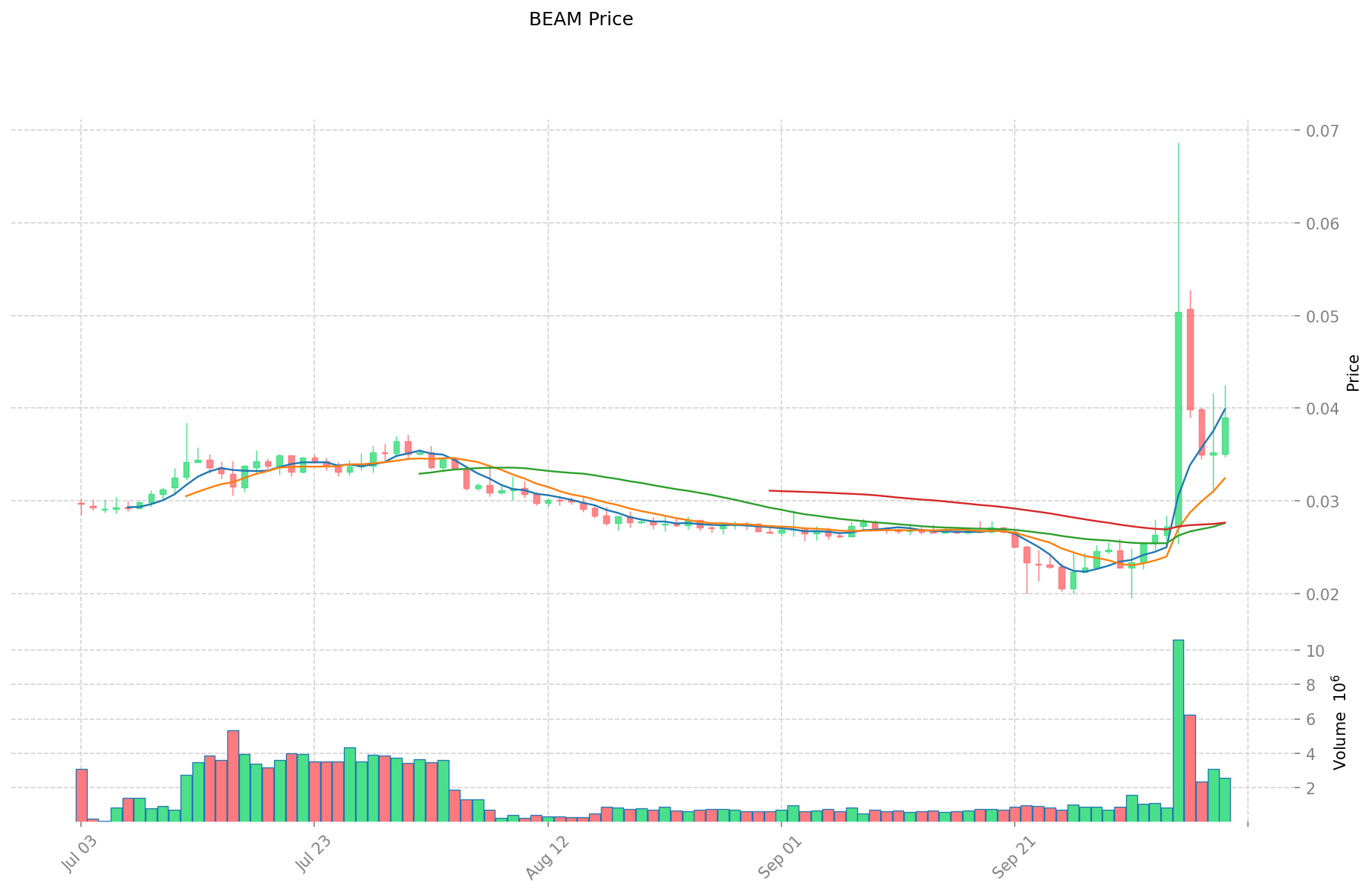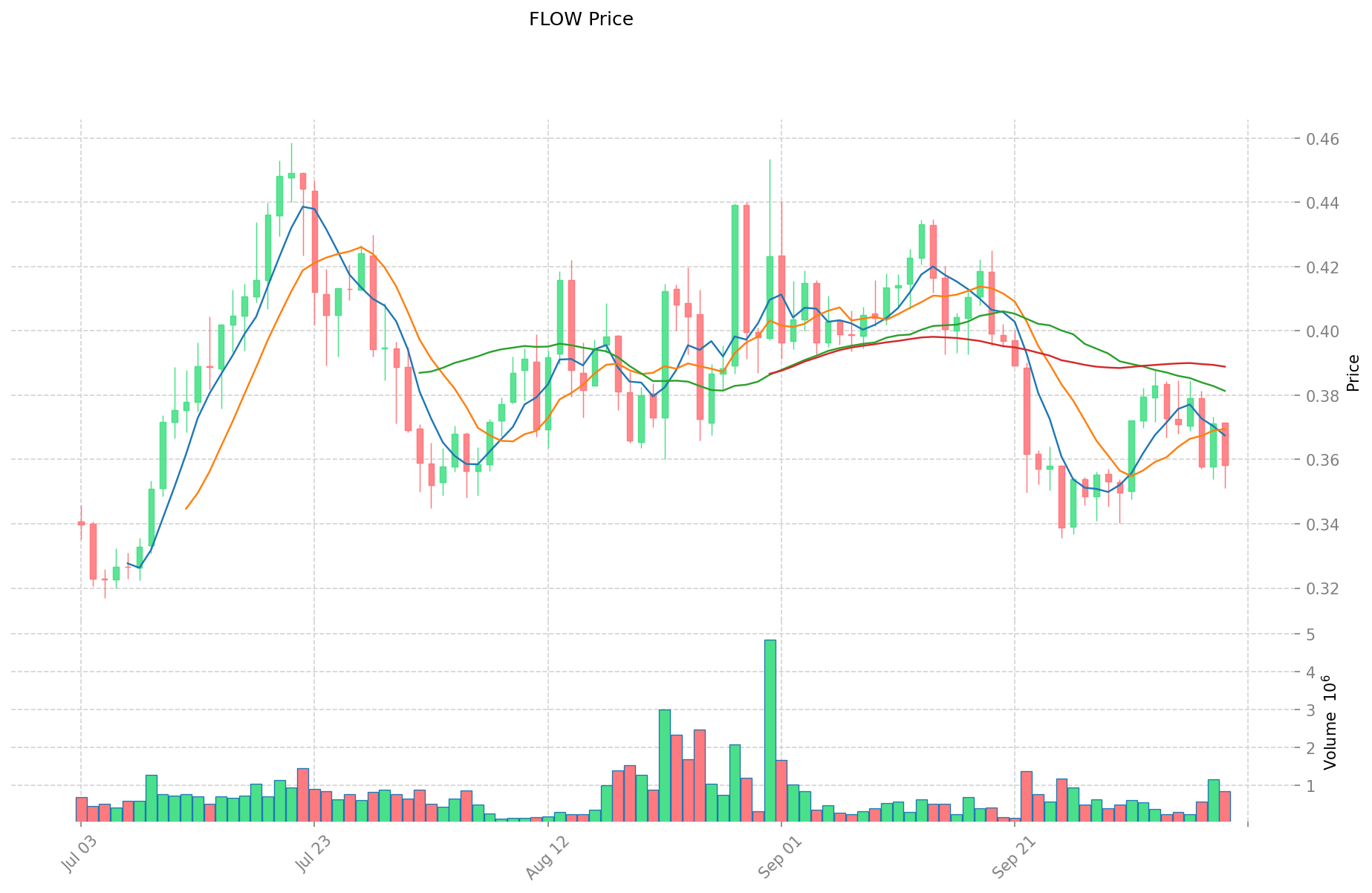BEAM vs FLOW: Comparing Two Leading Approaches in Distributed Computing Frameworks
Introduction: Investment Comparison of BEAM vs FLOW
In the cryptocurrency market, the comparison between BEAM and FLOW has always been an unavoidable topic for investors. The two not only have significant differences in market cap ranking, application scenarios, and price performance, but also represent different positioning in crypto assets.
BEAM (BEAM): Since its launch in 2019, it has gained market recognition for its strong privacy features based on the MimbleWimble protocol.
FLOW (FLOW): Introduced in 2020, it has been hailed as a platform for next-generation games and applications, becoming one of the cryptocurrencies with high global trading volume and market capitalization.
This article will provide a comprehensive analysis of the investment value comparison between BEAM and FLOW, focusing on historical price trends, supply mechanisms, institutional adoption, technological ecosystems, and future predictions, attempting to answer the question that investors are most concerned about:
"Which is the better buy right now?"
I. Price History Comparison and Current Market Status
BEAM (Coin A) and FLOW (Coin B) Historical Price Trends
- 2019: BEAM reached its all-time high of $4.28 on January 5, 2019, shortly after its launch.
- 2021: FLOW hit its all-time high of $42.40 on April 5, 2021, during the broader cryptocurrency bull market.
- Comparative analysis: In the recent market cycle, BEAM dropped from its all-time high of $4.28 to a low of $0.01941531, while FLOW declined from its peak of $42.40 to a low of $0.292024.
Current Market Situation (2025-10-10)
- BEAM current price: $0.03927
- FLOW current price: $0.3586
- 24-hour trading volume: BEAM $95,973.64 vs FLOW $301,109.38
- Market Sentiment Index (Fear & Greed Index): 70 (Greed)
Click to view real-time prices:
- View BEAM current price Market Price
- View FLOW current price Market Price


II. Core Factors Affecting BEAM vs FLOW Investment Value
Supply Mechanisms Comparison (Tokenomics)
- BEAM: Supply capped at 262.8 million coins with deflationary model
- FLOW: Maximum supply of 1,399,326,762 FLOW with inflation rate between 3.75% and 0.5%
- 📌 Historical Pattern: Deflationary tokens like BEAM tend to appreciate more during bull cycles due to scarcity, while FLOW's controlled inflation model focuses on sustainable ecosystem growth.
Institutional Adoption and Market Applications
- Institutional Holdings: FLOW has attracted more institutional interest with partnerships including NBA, NFL, UFC, and major entertainment brands
- Enterprise Adoption: FLOW leads in enterprise applications with Dapper Labs' successful NFT projects like NBA Top Shot, while BEAM focuses on privacy applications and confidential transactions
- Regulatory Attitudes: FLOW enjoys broader regulatory acceptance due to KYC compliance and institutional partnerships, while BEAM's privacy focus faces more scrutiny in certain jurisdictions
Technical Development and Ecosystem Building
- BEAM Technical Upgrades: Confidential DeFi applications, implementation of atomic swaps, and LelantusMW protocol for enhanced privacy
- FLOW Technical Development: Multi-node architecture, resource-oriented programming with Cadence, and upgradeable smart contracts
- Ecosystem Comparison: FLOW has a more developed NFT and gaming ecosystem with significant mainstream adoption, while BEAM focuses on privacy-centric DeFi applications and confidential transactions
Macroeconomic and Market Cycles
- Performance in Inflationary Environments: BEAM's fixed supply model potentially offers better inflation hedge characteristics
- Macroeconomic Monetary Policy: Both tokens show correlation with broader crypto market reactions to Federal Reserve decisions
- Geopolitical Factors: BEAM's privacy features may gain appeal during periods of increased surveillance, while FLOW's entertainment focus makes it less susceptible to geopolitical tensions
III. 2025-2030 Price Prediction: BEAM vs FLOW
Short-term Prediction (2025)
- BEAM: Conservative $0.0278 - $0.0391 | Optimistic $0.0391 - $0.0548
- FLOW: Conservative $0.3401 - $0.3580 | Optimistic $0.3580 - $0.3866
Mid-term Prediction (2027)
- BEAM may enter a growth phase, with an estimated price range of $0.0369 - $0.0621
- FLOW may enter a consolidation phase, with an estimated price range of $0.3714 - $0.5441
- Key drivers: Institutional fund inflows, ETFs, ecosystem development
Long-term Prediction (2030)
- BEAM: Base scenario $0.0736 - $0.0758 | Optimistic scenario $0.0758 - $0.0758
- FLOW: Base scenario $0.5862 - $0.7034 | Optimistic scenario $0.7034 - $0.7034
Disclaimer
BEAM:
| 年份 | 预测最高价 | 预测平均价格 | 预测最低价 | 涨跌幅 |
|---|---|---|---|---|
| 2025 | 0.054852 | 0.03918 | 0.0278178 | 0 |
| 2026 | 0.06488208 | 0.047016 | 0.04325472 | 19 |
| 2027 | 0.0621034344 | 0.05594904 | 0.0369263664 | 42 |
| 2028 | 0.083226994452 | 0.0590262372 | 0.045450202644 | 50 |
| 2029 | 0.07610547893382 | 0.071126615826 | 0.05619002650254 | 81 |
| 2030 | 0.075824528801307 | 0.07361604737991 | 0.067726763589517 | 87 |
FLOW:
| 年份 | 预测最高价 | 预测平均价格 | 预测最低价 | 涨跌幅 |
|---|---|---|---|---|
| 2025 | 0.38664 | 0.358 | 0.3401 | 0 |
| 2026 | 0.4914624 | 0.37232 | 0.2345616 | 3 |
| 2027 | 0.544182912 | 0.4318912 | 0.371426432 | 20 |
| 2028 | 0.63932854336 | 0.488037056 | 0.35138668032 | 36 |
| 2029 | 0.6087774236544 | 0.56368279968 | 0.3325728518112 | 57 |
| 2030 | 0.70347613400064 | 0.5862301116672 | 0.510020197150464 | 63 |
IV. Investment Strategy Comparison: BEAM vs FLOW
Long-term vs Short-term Investment Strategy
- BEAM: Suitable for investors focused on privacy features and potential growth in confidential transactions
- FLOW: Suitable for investors interested in NFT and gaming ecosystems with mainstream adoption potential
Risk Management and Asset Allocation
- Conservative investors: BEAM: 20% vs FLOW: 80%
- Aggressive investors: BEAM: 40% vs FLOW: 60%
- Hedging tools: Stablecoin allocation, options, cross-currency portfolio
V. Potential Risk Comparison
Market Risk
- BEAM: Higher volatility due to lower market cap and trading volume
- FLOW: Susceptible to fluctuations in NFT and gaming market trends
Technical Risk
- BEAM: Scalability, network stability
- FLOW: Centralization concerns, potential security vulnerabilities in smart contracts
Regulatory Risk
- Global regulatory policies may have different impacts on both, with BEAM potentially facing more scrutiny due to its privacy features
VI. Conclusion: Which Is the Better Buy?
📌 Investment Value Summary:
- BEAM advantages: Strong privacy features, deflationary model, potential for appreciation in privacy-focused markets
- FLOW advantages: Established ecosystem, institutional partnerships, mainstream adoption in NFT and gaming sectors
✅ Investment Advice:
- Novice investors: Consider a higher allocation to FLOW due to its more established ecosystem and mainstream partnerships
- Experienced investors: Balanced approach with a slight tilt towards BEAM for potential privacy-driven growth
- Institutional investors: Focus on FLOW for its regulatory compliance and established partnerships, while keeping a small allocation in BEAM for diversification
⚠️ Risk Warning: The cryptocurrency market is highly volatile, and this article does not constitute investment advice. None
VII. FAQ
Q1: What are the key differences between BEAM and FLOW? A: BEAM focuses on privacy features using the MimbleWimble protocol, while FLOW is designed for next-generation games and applications. BEAM has a capped supply of 262.8 million coins, whereas FLOW has a maximum supply of 1,399,326,762 tokens with a controlled inflation rate.
Q2: Which cryptocurrency has shown better price performance historically? A: FLOW has shown better historical price performance, reaching an all-time high of $42.40 in April 2021, compared to BEAM's all-time high of $4.28 in January 2019.
Q3: How do the current market situations of BEAM and FLOW compare? A: As of 2025-10-10, BEAM's price is $0.03927 with a 24-hour trading volume of $95,973.64, while FLOW's price is $0.3586 with a 24-hour trading volume of $301,109.38.
Q4: What are the main factors affecting the investment value of BEAM and FLOW? A: Key factors include supply mechanisms, institutional adoption, technical development, ecosystem building, and macroeconomic conditions. FLOW has stronger institutional partnerships and a more developed NFT ecosystem, while BEAM offers unique privacy features.
Q5: What are the price predictions for BEAM and FLOW by 2030? A: By 2030, BEAM is predicted to reach a base scenario of $0.0736 - $0.0758, while FLOW is expected to reach $0.5862 - $0.7034 in the base scenario.
Q6: How should investors allocate their assets between BEAM and FLOW? A: Conservative investors might consider allocating 20% to BEAM and 80% to FLOW, while aggressive investors might opt for 40% BEAM and 60% FLOW. The exact allocation should depend on individual risk tolerance and investment goals.
Q7: What are the potential risks associated with investing in BEAM and FLOW? A: Both cryptocurrencies face market risks, technical risks, and regulatory risks. BEAM may face higher volatility and regulatory scrutiny due to its privacy features, while FLOW is susceptible to fluctuations in NFT and gaming market trends.
Share
Content